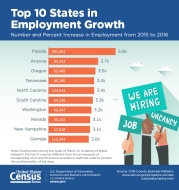For Immediate Release: Thursday, April 19, 2018
2016 County Business Patterns Shows Overall Growth in Employment
APRIL 19, 2018 — Construction led all sectors in the largest rate of employment growth with an increase of 5.0 percent from 2015 to 2016, according to new U.S. Census Bureau economic statistics released today. Overall, construction employment grew from 6.0 million in 2015 to 6.3 million in 2016. In addition, annual payroll in Construction (NAICS 23) grew 6.5 percent from $348.6 billion in 2015 to $371.3 billion in 2016; and average payroll per employee grew 1.4 percent from $58,020 to $58,824.
These statistics come from the 2016 County Business Patterns (CBP), which provides detailed annual information on the number of establishments, first quarter employment, and first quarter and annual payroll at the national, state, metropolitan area, county and congressional district levels for nearly 1,200 industries defined by the North American Industry Classification System (NAICS).
Highlights include:
- The number of all establishments rose 1.2 percent from 7,663,938 in 2015 to 7,759,807 in 2016. First quarter employment was up 2.1 percent from 124,085,947 to 126,752,238, and annual payroll was up 2.9 percent from $6.3 trillion in 2015 to $6.4 trillion in 2016.
- The largest employment gains in Construction occurred in California (36,817), Florida (33,463) and New York (27,662). Employment gains in Specialty Trade Contractors (NAICS 238) (221,140) led this growth with Building Finishing Contractors (NAICS 2383) increasing the most among Specialty Trade Contractors with a growth of 93,209 employees.
- The greatest number of employees was in Health Care and Social Assistance (NAICS 62), which rose 2.7 percent to 19.7 million employees working at 890,519 establishments in 2016.
- Food Services and Drinking Places, (NAICS 722) had the largest increase in first quarter employment with an increase of 4.2 percent from 11,164,851 in 2015 to 11,636,640 in 2016.
- The largest percentage increases in first quarter employment among states occurred in Florida (5.0 percent) and Arizona (3.7 percent).
- Among the top 50 U.S. counties with the most employees, the top three for employment growth were:
- Wake County, N.C., (whose largest city is Raleigh) with a growth of 5.2 percent and an employment increase of 22,293.
- Kings County, N.Y., (whose largest borough is Brooklyn) with an increase of 28,282 employees and a growth of 4.9 percent.
- Bexar County, Texas, (whose largest city is San Antonio) with an increase of 31,394 in employment, representing 4.4 percent growth.
Tools for Accessing CBP
CBP data can be accessed using multiple tools available via the Census Bureau’s website, including American FactFinder, QuickFacts, Census Business Builder and My Congressional District. Data for QuickFacts, Census Business Builder and My Congressional District are not available now but are released on a flow basis.
About the Program
CBP statistics are based on data from employer establishments as represented on the Census Bureau’s Business Register. The Business Register is a database of all known single and multiestablishment employer companies. The Business Register contains the most complete, current and consistent data for business establishments. The annual Company Organization Survey and the quinquennial economic census provide individual establishment data for multiestablishment companies. Data for single-establishment companies are obtained from various Census Bureau programs, such as the economic census, Annual Survey of Manufactures and other Census Bureau surveys, as well as from administrative record sources.
CBP covers most of the country's economic activity. However, the statistics exclude data from self-employed individuals (i.e., nonemployers), employees of private households, railroad employees, agricultural production employees, and most government employees.
Statistics are provided by employment-size classes (e.g., number of establishments with one to four employees) and legal form of organization, such as corporations and partnerships (available at the U.S. and state level). Definitional and coverage differences may affect the direct comparisons of economic census data and County Business Patterns statistics. See the program methodology for more details.
ZIP Code Business Patterns will be released in May 2018.
Information on businesses without paid employees will be released as part of the upcoming 2016 Nonemployer Statistics report in May 2018.
County Business Patterns statistics are also available for Puerto Rico, Guam, American Samoa, the Commonwealth of the Northern Mariana Islands and the U.S. Virgin Islands.
County Business Patterns debuted 72 years ago and has been published annually for the past
52 years, starting in 1964.
Other Sources of Local Area Economic Data
The Census Bureau conducts an economic census every five years to provide a comprehensive and detailed profile of the U.S. economy, covering millions of businesses representing more than 1,000 industries and providing unique portraits of American industries and local communities.
No news release associated with this report. Tip sheet only.
###
County Business Patterns defines employment as all full- and part-time employees who were on the payroll during the pay period that includes March 12. Data are obtained from Census Bureau reports and administrative records from other federal agencies. Quality assurance procedures are applied to all phases of collection, processing and tabulation to minimize errors. The data are subject to nonsampling error from miscoding and imputation for missing or misreported data. Values associated with each establishment are slightly modified to protect the confidentiality of each location’s data. Data from NAICS sector 99, Industries Not Classified, are not included in this summary. Further information about methodology and data limitations is available at www.census.gov/programs-surveys/cbp/technical-documentation/methodology.html.





